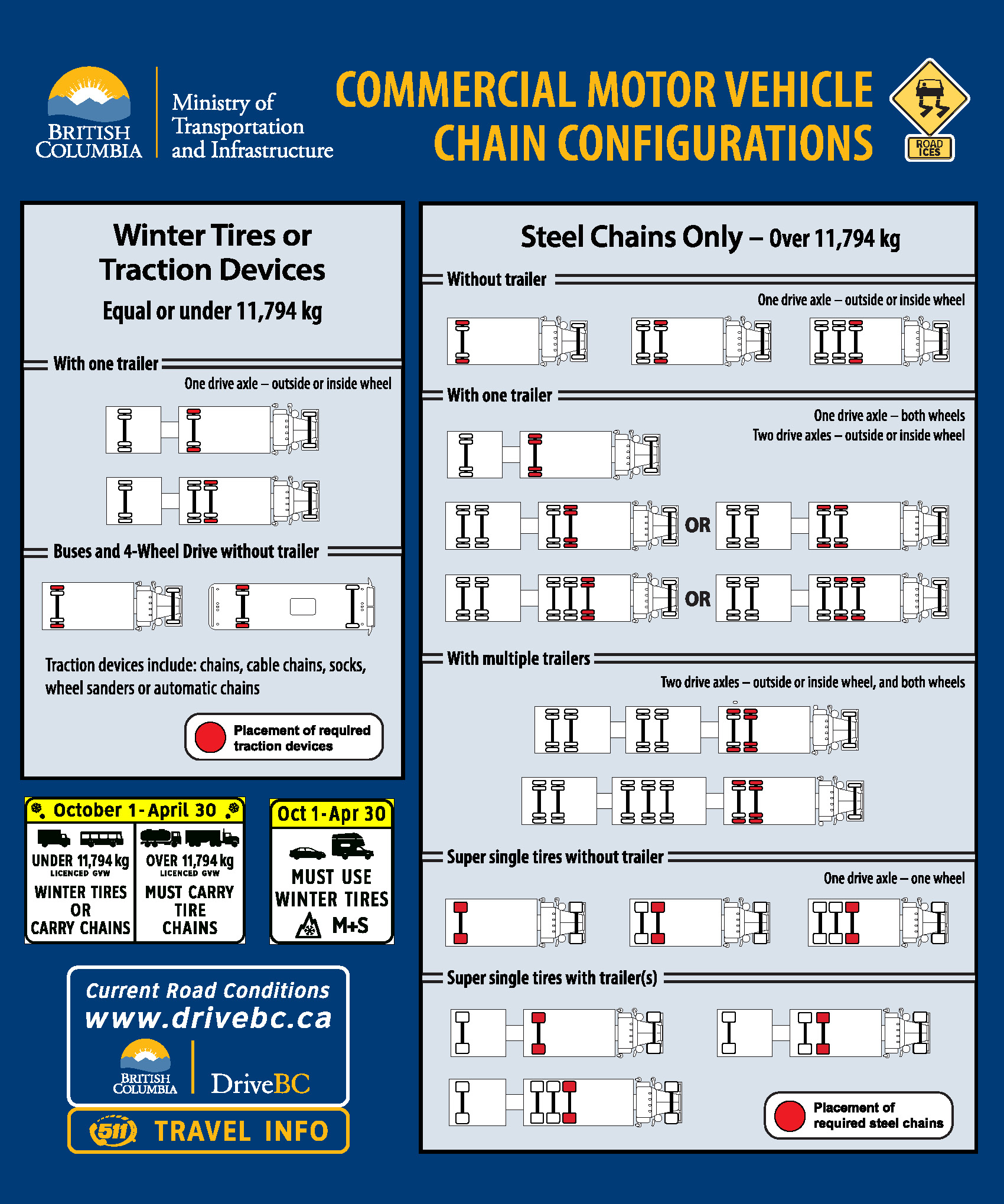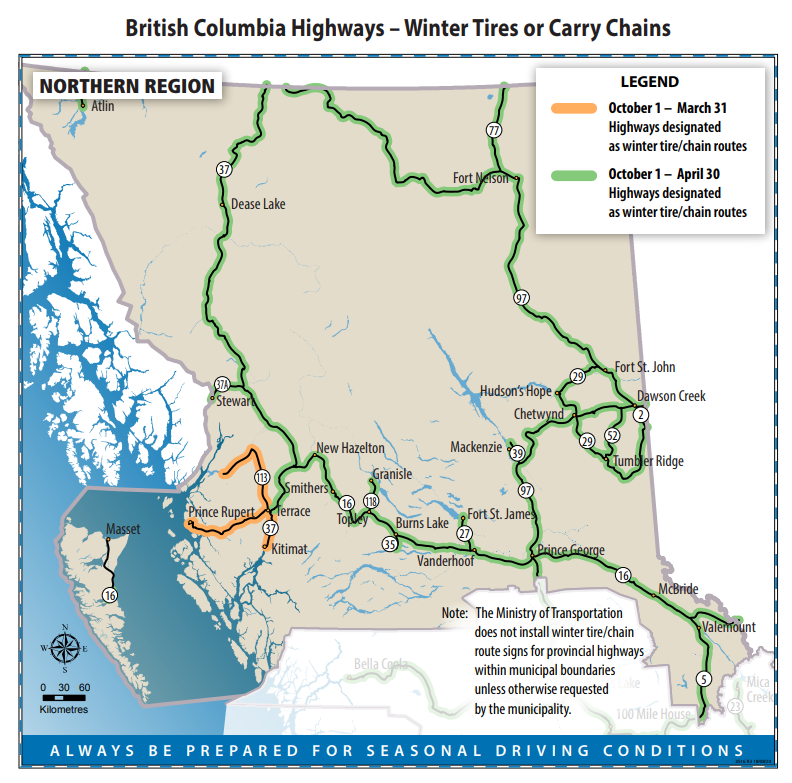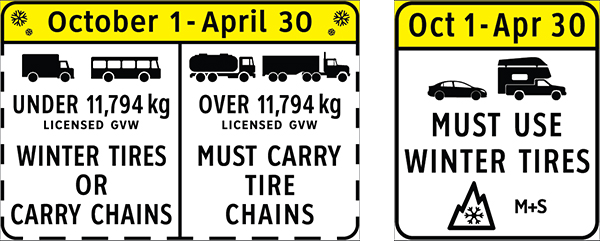About Winter Tires What is a Legal Winter Tire in BC. Winter tire regulations still in effect for some highways across BC Apr 3 2020 1207 PM VICTORIAThe Ministry of Transportation is reminding British Columbians that winter tire regulations are in effect until the end of April.
 Passenger Vehicle Tire And Chain Requirements Province Of British Columbia
Passenger Vehicle Tire And Chain Requirements Province Of British Columbia
Winter tires or chains are required on most routes in BC from October 1 to April 30.

Snow tire regulations bc. In BC winter tires are defined as those labelled with either the Mountain Snowflake symbol or the Mud and Snow MS symbol. BC is one of only three provinces in Canada that define a winter tire and specify where their use is required. Highways so people should ensure their vehicle is equipped with tires with the mountainsnowflake or mud and snow M S symbol when travelling on designated routes.
Drivers must obey winter tire and chain signs throughout the province from October 1 to April 30. The tires must don the MS mud snow symbol or the three-peaked snowflakemountain symbol see below. Winter tires or chains are required on most routes in BC from October 1 to April 30.
Winter tires must be in good condition with a minimum tread depth of 35 mm and must be used starting Oct. As of Oct. Highways outside of the Lower Mainland and southeastern Vancouver Island will be required to have.
Winter tires or chains are required on most routes in British Columbia from October 1 to April 30. This symbol is located on the sidewall of the tire. The two tires on the primary drive axle must be matching.
Highways so people should ensure their vehicle is equipped with tires with the mountainsnowflake or mud and snow M S symbol when travelling on designated routes says the Ministry of. Winter tire regulations remain in place on several Highways across BC until April 30. These routes are marked with regulatory signs posted on highways throughout the province.
Winter tires are required on most highways in BC. Winter tires must also have at least 35 millimetres of tread. These routes are marked with regulatory signs posted on numbered and un-numbered highways throughout the province.
On October 1 2014 the Ministry of Transportation and Infrastructure announced new winter tire rules for British Columbia. Winter tire regulations are in effect for most BC. Winter Tire and Chain-up Routes and Dates.
Ministry of Transportation Look for the snowflake or MS Winter tires sometimes called alpine or snow tires. For select highways not located through mountain passes andor high snowfall areas tire and chain requirements end March 31. Some winter tire manufactures label with both symbols.
For select highways not located through mountain passes andor high snowfall areas tire and chain requirements end March 31. The tires must also have a minimum of 35mm of tread depth. Learn more about winter tire and chain requirements in BC.
Approved winter tires in BC. To be considered a winter tire a MS or a mountainsnowflake tire must also have at least 35mm of tread depth. Winter tire regulations are in effect for most BC.
Winter Tires in BC Winter tires are required in BC on many rural highways and high mountain passes in the Interior North and Vancouver Island. For select highways not located through mountain passes andor high snowfall areas tire and chain requirements end March 31. A legal winter tire on a standard passenger vehicle or a four-wheelall-wheel vehicle MUST have at least 35 mm of tread depth.
Tires must be in good condition and have a. DRIVERS are reminded that winter tire regulations remain in place until April 30 on many highways to account for early spring snowfall. The letters M and S the minimum legal requirement mud snowall season tires.
1 any driver on BC. Drivers must obey winter tire and chain signs throughout the province from October 1 to April 30. For select highways not located through mountain passes andor high snowfall areas tire and chain requirements end March 31.
These routes are marked with regulatory signs posted on numbered and un-numbered highways throughout the province. Drivers are encouraged to choose their tires based on the region and conditions in. A winter tire must be labelled with either of the following.
Definition of a Winter Tire. Signs are posted to identify these designated highways. Either have the MS mud and snow or three-peaked mountain and snowflake symbol.
Both the all-season Mud and Snow MS tires and the mountainsnowflake tires meet the requirements for winter tire designation in BC. The changes are part of the Rural Highway Safety and Speed Review conducted by the Ministry about one year ago when BC residents were asked to express their opinion. In BC regulations state that an appropriate winter tire is defined as one with either the MS or mountainsnowflake symbol and in good condition with a minimum tread depth of 35 millimetres.
For select highways not located through mountain passes andor high snowfall areas tire and chain requirements end March 31.
BCs winter tire regulations officially take effect today. Tire Size Thread Depth Width and Snow Chains Regulations USA and Canada As of October 1 BC law requires that all vehicles travelling on specific highways have winter tires.
 Commercial Vehicle Tire And Chain Requirements Province Of British Columbia
Commercial Vehicle Tire And Chain Requirements Province Of British Columbia
DRiverswho are not compliant with BCs winter tire regulations can be fined or turned away from travelling on certain highways.

Bc tire regulations. Signs are posted on these designated highways to advise drivers where and when winter tires are required. Tires must be in good condition and have a. The letters M and S the minimum legal requirement mud snowall season tires.
Along with the province trucking associations are also reminding drivers to prepare for the winter conditions before it is too late. The province requires passenger vehicles be equipped with winter tires between Oct. Drivers are encouraged to choose their tires based on the region and conditions in which they regularly drive.
A legal winter tire on a standard passenger vehicle or a four-wheelall-wheel vehicle MUST have at least 35 mm of tread depth. 5 No person shall without an overload permit issued under the Commercial Transport Regulations BC. Gary McLeod is the manager of the Northern BC Truckers Association.
Along with the province trucking associations are also reminding drivers to prepare for the winter conditions before it is too late. Regulations state that an appropriate winter tire is defined as one with either the MS or mountainsnowflake symbol and in good condition with a minimum tread depth of 35 millimetres. Designated Winter Tire and Chain-up Routes Along with the province trucking associations are.
Routes requiring winter tires Certain highways in BC. Chains on heavy commercial motor vehicles with trailers and super single tires. Chains on heavy commercial motor vehicles with one trailer.
Winter tires or chains are required on most routes in BC from October 1 to April 30. In a single-tire application eg the steering axel with a maximum weight of 12000 lb each 11 in. Wide tire would have to carry 6000 lb.
People driving to or through British Columbia should now have winter tires on their vehicle its the law. Winter tires or chains are required on most routes in British Columbia from October 1 to April 30. Vehicles not equipped with winter.
Chains on heavy commercial motor vehicles with more than one trailer. Chains on heavy commercial motor vehicles without trailers. In British Columbia BC Under the Motor Vehicle Act Regulations tires with studs up to 35 mm high can only be used between October 1 and April 30.
Or approximately 545 lb. Chains on light commercial motor vehicles. Highways so people should ensure their vehicle is equipped with tires with the mountainsnowflake or mud and snow M S symbol when travelling on designated routes.
Winter tire regulations are in effect for most BC. About Winter Tires What is a Legal Winter Tire in BC. On October 1 2014 the Ministry of Transportation and Infrastructure announced new winter tire rules for British Columbia.
3078 drive or operate on a highway a vehicle so loaded that the tires are loaded above the maximum load specified by the tire manufacturer for the tire size ply rating and service speed. For select highways not located through mountain passes andor high snowfall areas tire and chain requirements end March 31. According to Ministry of Transportation guidelines drivers are required to use winter tires on their vehicles if they are.
These routes are marked with regulatory signs posted on numbered and un-numbered highways throughout the province. States may limit tire loads on the Interstate System but not to less than 500 pounds per inch of tire or tread widths. The regulations limit tires to 130 studs each for vehicles weighing less than 4600 kg or 175 studs each for vehicles weighing more than that.
British Columbia Tire Regulations As of October 1 BC law requires that all vehicles travelling on specific highways have winter tires. These routes are marked with regulatory signs posted on highways throughout the province. Require cars and light trucks to use winter tires from October 1 to March 31.
The provincial government is advising drivers that winter tires are mandatory for those travelling on most of BCs highways starting Thursday October 1 2020. A winter tire must be labelled with either of the following. As of October 1 BC law requires that all vehicles travelling on specific highways have winter tires.
For select highways not located through mountain passes andor high snowfall areas tire and chain requirements end March 31. British Columbia Tire Regulations. The changes are part of the Rural Highway Safety and Speed Review conducted by the Ministry about one year ago when BC residents were asked to express their opinion.
In BC regulations state that an appropriate winter tire is defined as one with either the MS or mountainsnowflake symbol and in good condition with a minimum tread depth of 35 millimetres.
According to Ministry of Transportation guidelines drivers are required to use winter tires on their vehicles if they are. Only British Columbia and Quebec have made them mandatory by law during the winter months.
 Enforcement Of Winter Tires Chains Requirements Province Of British Columbia
Enforcement Of Winter Tires Chains Requirements Province Of British Columbia
Highways so people should ensure their vehicle is equipped with tires with the mountainsnowflake or mud and snow M S symbol when travelling on designated routes.
Bc winter tire regulations. For select highways not located through mountain passes andor high snowfall areas tire and chain requirements end March 31. Well not all the time mostly in October when winter tire regulations go into effect on most BC highways until the end of March. What provinces have mandatory winter tires.
British Columbia Tire Regulations As of October 1 BC law requires that all vehicles travelling on specific highways have winter tires. BCs winter tire and chain requirements come back into effect on Thursday. BC is one of only three provinces in Canada that define a winter tire and specify where their use is required.
The letters M and S the minimum legal requirement mud. These routes are marked with regulatory signs posted on highways throughout the province. The RCMP may turn all vehicles away if they think conditions are unsafe.
Highways outside of the Lower. Winter tires are required in BC on many rural highways and high mountain passes in the Interior North and Vancouver Island. In a single-tire application eg the steering axel with a maximum weight of 12000 lb each 11 in.
Wide tire would have to carry 6000 lb. For select highways not located through mountain passes andor high snowfall areas tire and chain requirements end March 31. Drivers must obey winter tire and chain signs throughout the province from October 1 to April 30.
A legal winter tire on a standard passenger vehicle or a four-wheelall-wheel vehicle MUST have at least 35 mm of tread depth. Heads up to residents travellers and road trippers. Winter tires or chains are required on most routes in BC from October 1 to April 30.
Gary McLeod is the manager of the Northern BC Truckers Association. 1 to March 30 on the routes depicted below though they have been extended to April in certain mountain passes. Require cars and light trucks to use winter tires from October 1 to March 31.
A winter tire must be labelled with either of the following. Winter tire regulations are in effect for most BC. BCs winter tire regulations officially take effect today.
Drivers must obey winter tire and chain signs throughout the province from October 1 to April 30. Along with the province trucking associations are also reminding drivers to prepare for the winter conditions before it is too late. Signs are posted to identify these designated highways.
Tires must be in good condition and have a. States may limit tire loads on the Interstate System but not to less than 500 pounds per inch of tire or tread widths. Certain highways in BC.
1 any driver on BC. Or approximately 545 lb. Winter tires must be in good condition with a minimum tread depth of 35 mm and must be used starting Oct.
Drivers are encouraged to choose their tires based on the region and conditions in which they regularly drive. Vehicles not equipped with winter tires are prohibited from travelling past the signs. BCs winter tire regulations apply from Oct.
For select highways not located through mountain passes andor high snowfall areas tire and chain requirements end March 31. On October 1 2014 the Ministry of Transportation and Infrastructure announced new winter tire rules for British Columbia. This symbol is located on the sidewall of the tire.
For select highways not located through mountain passes andor high snowfall areas tire and chain requirements end March 31. Winter tires or chains are required on most routes in British Columbia from October 1 to April 30. These routes are marked with regulatory signs posted on numbered and un-numbered highways throughout the province.
The changes are part of the Rural Highway Safety and Speed Review conducted by the Ministry about one year ago when BC residents were asked to express their opinion. They are required by law in British Columbia between October 1st and April 30th on most BC highways as indicated by the road sign below. Studded tires may only be used.
We get questions about winter tires all the time. Definition of a Winter Tire BCs Motor Vehicle Act creates the authority to designate roads where winter tires are required. Signs are posted on these designated highways to advise drivers where and when winter tires are required.
The provincial government is advising drivers that winter tires are mandatory for those travelling on most of BCs highways starting Thursday October 1 2020. What is a Legal Winter Tire in BC. Trucks travelling these routes must.
In BC winter tires are defined as those labelled with either the Mountain Snowflake symbol or the Mud and Snow MS symbol. In BC regulations state that an appropriate winter tire is defined as one with either the MS or mountainsnowflake symbol and in good condition with a minimum tread depth of 35 millimetres.
-
Thanks for visiting our Job Board. If you were in charge what would you do to make WOLVERINE FREIGHT SYSTEM a better place to work. Dedic...
-
Time for your cheat sheet on this weeks top stories. 1014373 confirmed cases 58673 active 932582 resolved 23118 deathsThe total case count ...
-
81 agreed natural resource development oil gas renewable energy forestry mining agriculture and fishing is good for Canada. The natural res...
joseph and his brothers in the bible
What is the story of Joseph and his brothers? . One day, Joseph traveled to check on his brothers while they were watching their sheep...

ads
